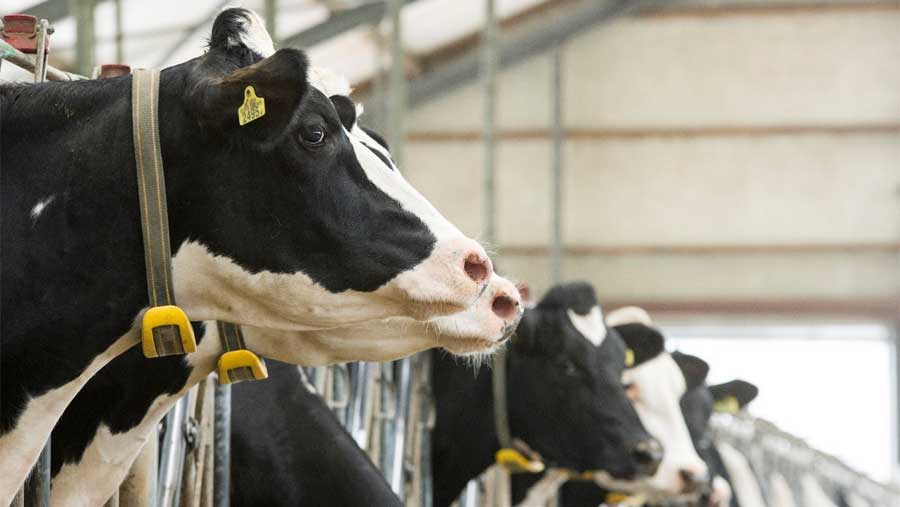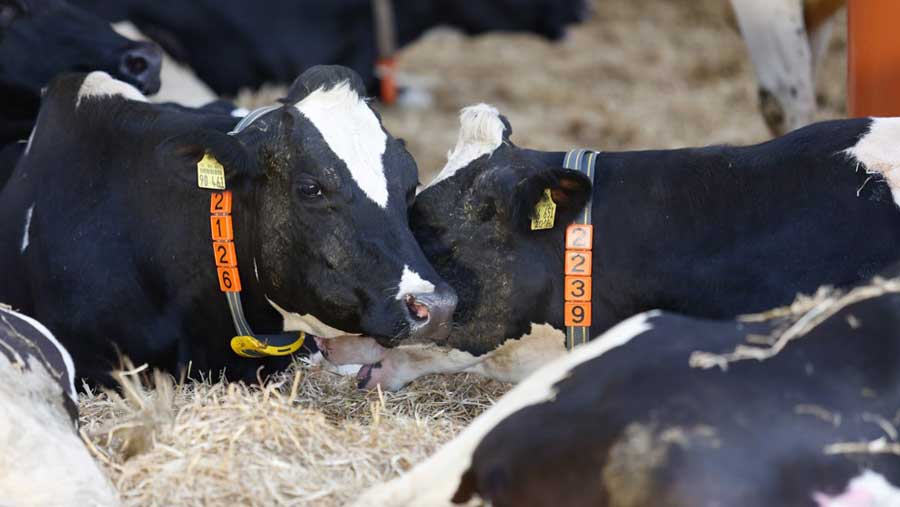Advertiser content
How to identify cow health issues before they become problems
With farm scale increases on the rise, being able to monitor each animal is becoming increasingly difficult. When herd managers and farm employees are stretched too thin, individual cow attention becomes more challenging.
If you are not able to monitor your cows 24/7, you may be missing key critical cow health problems on your farm.

The unknown but undisputed ROI of activity monitors
Activity monitors are well known to detect heats 24 hours a day and pinpoint the optimal insemination moment of cows to be bred.
The result is more comprehensive heat detection and the ability to use labor elsewhere. Its return on investment is evident because of improved conception rates, reduced breeding costs and shorter open periods.
However, the most advanced systems nowadays have much more to offer than just that.
Nedap CowControl continuously monitors eating activity, rumination patterns and inactive behavior of individual cows and groups.
Based on these data, the system brings actionable insights to your fingertips to accurately determine their health, well-being and nutritional status and identify bottlenecks.
This helps you improve cow health and longevity, save on recourses and increase the herd’s productivity.
Learn how automated cow health and herd performance monitoring can quickly pay for itself on your dairy operation.
Stay ahead of disease. Keep cows healthy and productive.
Could you be missing cases of ketosis, subclinical mastitis, displaced abomasums, lameness or other cow diseases? Ilnesses don’t wait. Neither should you.
State-of-the-art systems like Nedap CowControl can help you quickly detect health issues days before their symptoms are visible to the human eye.
Finding and addressing potentially sick cows saves time, medical costs, death loss and milk production because the cows can bounce back quickly and return to peak milk sooner.
What about the economics? For example, displaced abomasums can cost at least € 275 per case and take up to two weeks for the cow to resume normal milk production [1].
Ketosis can cost a 200-cow dairy with a 30% ketosis rate about € 15.180 a year. By lowering the ketosis rate by just 5%, the dairy could save € 2.530 per year [2]. And that’s beneficial to both you and your cows.
Total chewing time counts:
Activity monitors don’t pinpoint specific diseases. But they do let you know which cows need attention and they give you the extra information to diagnose their situation.
To be able to provide the most accurate and complete information, Nedap CowControl monitors eating activity, rumination patterns and inactive behavior during which the cow is neither eating nor ruminating.

Cows need to spend sufficient time eating and ruminating. It’s the total chewing time that counts. A reduced rumination time in itself doesn’t necessarily indicate a problem. It might simply be the result of a change in diet.
Pasture access for example results in a dramatic change in eating and rumination time compared to silage.
But the total chewing time remains constant. When the total chewing time drops, that’s when your cows run into trouble.
And that’s why urgent alerts within Nedap CowControl are based on the cow’s inactive behavior.
Since it’s not only the very urgent cases that matter, the system also provides a list of cows that need to be checked because one or more behavioral aspects deviate from a cow’s previous patterns or those of the group she is in.
Easy-to-understand reports provide deeper insight into her current and historic behavior to help dairymen decide which action to take.
Even after action is taken, these reports can contribute to measure post-treatment recovery.
Cows that don’t bounce back to their normal levels during recovery might need additional clinical examination to be a step ahead of more serious problems.
Get the most out of your dry and fresh cows
Individual attention to dry and fresh cows is often limited. These groups don’t get regular checks in the milking parlor and there are hardly any tools to consistently monitor them without the need for extra labor.
Closely monitoring the behavior of cows around calving enables you to identify which cows need extra attention during this risky transition period.
The period they are more susceptible to disease because of changes in the environment, feed and their energy and stress levels.
Also, proper dry and fresh cow management determines the success of a good startup after calving and drives high production and fertility results later on in their lactation.
Sufficient and stable feed intake before and straight after calving are essential.
They ensure the healthy energy balance and condition needed to quickly start off and maintain milk production at a high level.
Closely monitoring eating activity in this period enables you to know if the feed intake of specific cows is on track or off the record.
Drops in rumination patterns and inactive behavior peaks might indicate rumen health issues occur that can lead to illnesses like ketosis, acidosis, displaced abomasum and milk fever.
It’s therefore not surprising that many farmers successfully apply this sensor information in their dry and fresh cow protocols.
It allows them to get the most out of their activity monitoring system and, more importantly, their cows.

Alex Borst, Herd Manager at Koepon Dairy Farm in The Netherlands:
We closely monitor the transition list and set goals for the cows that have calved during the past week. A cow is only allowed to return from the straw box to the herd when she eats and ruminates sufficiently.
Read Alex’s success story
Knowing your herd’s performance trends to make the right decisions
Nedap CowControl monitors behavior on group and herd level as well.
You not only get an alert if a certain percentage of the cows in a group are showing abnormal behavior, which indicates something might affect their performance.
Group and herd insights also help you identify management areas that need improvement and give feedback on the impact of management changes.
Think of areas or changes in the field of nutrition, housing, handling and employee performance.
A few examples that may apply to your dairy: if you see chewing time drop in a whole group of cows, it could indicate their ration is imbalanced. If you change your feed pushing strategy, the ‘group eating pattern’ report directly shows its impact.
If you notice a group of cows is suddenly very active, that might mean someone left the gate open. Or if the herd structurally shows long periods of inactive behavior, lockup times may be too long.
Management improvements based on these insights pay off in terms of cow comfort, production, health and longevity.
Team up with technology
Farmers cannot do without technology and technology cannot do without farmers. Activity monitors relieve farmers of a huge amount of work and labor.
They are able to do specific tasks more effective and provide information that might go unseen without them.
They certainly won’t replace dairyman, but they do enable them to spend their time more efficiently while performing more productive tasks on the farm or spend time away from it.
The other way around, activity monitors need the farmer’s craftsmanship and expertise. Without them there is no adequate follow-up of alerts, no correct interpretation of sensor insights and no decisions based upon them.
One could say they need each other to reach their full potential. So team up with technology to get the most out of your activity monitoring system and your dairy operation.
Where to start?
Leading international genetics and milking equipment suppliers partner with Nedap to include its activity monitoring system in their solutions. Learn more about Nedap CowControl and find your supplier at nedap.com/cowcontrol
[1] Bartlett PC, Kopcha M, Coe PH, Ames NK, Ruegg PL, Erskine RJ. (1995 Economic comparison of the pyloro-omentopexy vs the roll-and-toggle procedure for treatment of left displacement of the abomasum in dairy cattle. Journal of the American Veterinary Medical Association [01 Apr 1995, 206(8):1156-1162]).
[2] McArt, J. A. A., Nydam, D. V, & Overton, M. W. (2015 Hyperketonemia in early lactation dairy cattle: a deterministic estimate of component and total cost per case. Journal of Dairy Science, 98(3), 2043–54).
Provided by
Helping livestock farmers to be the best performing farmers in the world
For more than 40 years, Nedap strengthens farmers through the most reliable and innovative animal identification, monitoring and automation solutions. They empower managers and personnel with dependable information to make operational and strategic decisions and help farmers be more efficient, productive and successful.
For more information, please visit nedap.com/cowcontrol
